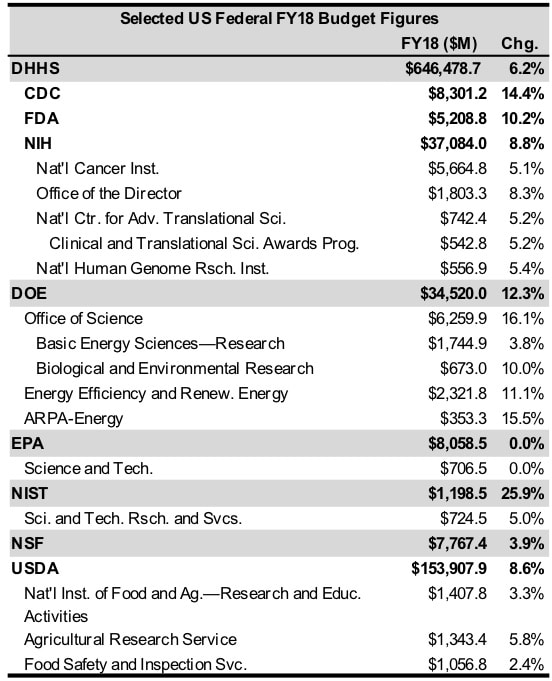The FY18 Federal Budget Brings Records Gains for US Science
Signed into law on March 23, the US federal budget for fiscal year 2018 (October 1, 2017–September 30, 2018) provides good news for scientists and researchers and, consequently, analytical instrument and laboratory supply companies. The American Association for the Advancement of Science labeled it the largest percentage increase in over 10 years in federal R&D funding, estimating a 12.8% jump to $176.8 billion.
The table below details agency and program increases for entities determined to be among the largest purchases of laboratory solutions for R&D whose funding amount was listed in budget documents. The figures in the table and information in this article are based on Congressional documents. The details below are selected to provide highlights related to laboratory product and instrument purchases.
NIH
The NIH and FDA are among the beneficiaries of a 6.2% increase in Department of Health and Human Sciences’ funding to more than $37 billion. The NIH is one of the federal government’s largest funders of R&D. A driver of new NIH R&D funding in recent years has been the 2016 21st Century Cures Act see (IBO 1/15/17). This year, the NIH received $496 million due to the Act, a 4.1% increase.
Funding from the Act went in part to specified programs, resulting in a 29.3% increase in research funding for Alzheimer’s disease to $1,828 million; an 18.8% increase to $380 million in All of Us precision medicine funding; a 53.8% million increase in BRAIN Initiative funding to $4 billion; and an $8 million increase in regenerative medicine funding. The NIH’s universal flu vaccine research also received a shot in the arm, with a 66.7% increase to $100 million. This research will be conducted by the National Institute of Allergy and Infectious Diseases.
In other good news, NIH Research Project Grants received an 8.8% increase in funding. In addition, younger researchers are a focus. Referring to these monies, Congressional documents read, “The agreement expects that NIH will continue its focus on emerging investigators and first-time renewals of these young investigators with actions to significantly reduce the average age of an NIH-supported new investigator.”
One field that was designated for supplemental research funding is trisomy 21. The NIH Office of Director was directed by Congress to develop an initiative across the NIH to study trisomy 21, or Down syndrome. Discussing the undertaking, Congress wrote that the initiative should be undertaken “with the aim of yielding scientific discoveries to improve the health and neurodevelopment of individuals with Down syndrome and typical individuals at risk for Alzheimer’s disease, cancer, cardiovascular disease, immune system disregulation and autism, among others.”
Also called out by Congress were several FDA programs as part of an overall 10.2% increase for the Agency to $5.2 billion. Funding increases provided for existing programs included a one million dollar increase for research reviewing botanical drug and dietary supplement interactions, a $400,000 increase for the Critical Path Initiative, and a $60 million increase, up 200%, for the FDA Innovation Account for implementation of the 21st Century Cures Act. As part of a broader commitment to addressing the opioid addiction crisis, the FDA was directed to purchase technology to inspect incoming foreign packages at International Mail Facilities for illicit substances, as well as “to identify unapproved and counterfeit pharmaceuticals, and to upgrade laboratory facilities used in this effort.”
Surpassing the FDA’s rise in funding was the CDC, which received a 14.4% increase for a total budget of more than $8 billion. For the CDC, specific funding included $58 million for Food Safety as part of total funding of $614.6 million, a 5.1% increase, for Emerging and Zoonotic Infectious Diseases. In addition, replacement of one of the US’ Biosafety Level 4 Labs was addressed with a $480 million commitment.
DOE
Like the CDC, the DOE Office of Science received a hefty double-digit percentage hike in its budget for FY18 to $6.3 billion. Highlights of the DOE Office of Science’s funding for research and testing, as noted in Congressional documents, included at least $130.5 million for Nanoscale Science Research Centers and a minimum of $110 million for the Energy Frontier Research Centers, both part of the Office of Basic Energy.
Within the Office of Biological and Environmental Research, the budget allocated $90 million for the Bioenergy Research Centers, including $15 million for a new awardee, at least $69.3 million for the Joint Genome Institute and $43.2 million for the Environmental Molecular Sciences Laboratory. In particular, Congress noted, “[T]he Department is directed to maintain Genomic Science as a top priority and continue to support the Mesoscale to Molecules Activity.”
EPA
As a result of the FY18 budget, the EPA is safe from some of the more devastating proposals to curtail its programs. Specifically, no EPA regional offices will be closed in fiscal 2018. Nonetheless, the EPA’s budget was held flat at $8.1 billion. Although funding for Chemical Safety and Sustainability received no increase, specific program funding was designated. As part of the EPA Science and Technology office’s investment in Computational Toxicology, the EPA was directed to “to develop the strategic plan on alternative methods and testing strategies” for the Lautenberg Chemical Safety Act.
USDA
Fairing much better than the EPA was the USDA, whose budget rose 8.6% to nearly $154 billion. A specific research program called out in Congressional documents as part of funding for the National Institute of Food and Agriculture—Research and Education was $400 million for the Agriculture and Food Research Initiative.



